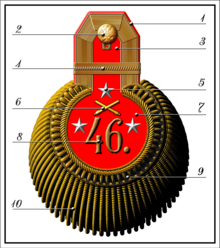Talk:Epaulette
| This article is rated Start-class on Wikipedia's content assessment scale. It is of interest to the following WikiProjects: | |||||||||||||||||||||||
| |||||||||||||||||||||||
In "The Big Bang Theory", S02E14, Sheldon cites the epaulette as an example of women's fashion derived from military uniform. Is this true? Have epaulettes been fashionable (like berets)?
German Army
[edit]The article says "German Army uniforms are known for a four cord braided "figure-of-eight" decoration which acts as a shoulder board. This is called a shoulder knot." This only applies to the old Wehrmacht shoulder boards. The German Army (Bundeswehr) does not have decorative shoulder boards. Please correct this. 84.143.229.194 (talk) 16:50, 10 August 2010 (UTC)
- And a shoulder board is not an epaulette. Since the other national listings deal with epaulettes (with the exception of Canada, which ignores the definition given in the introduction of this article, likewise the section on UK Police shoulder markings, and which both belong in the Shoulder marks article), this text should also be deleted on grounds of consistency. And Venezuela, Chile, Colombia, Ecuador and Bolivia are not Germany. Description of actual epaulette wear is what is needed here, consistent with other listings. Robocon1 (talk) 09:41, 15 May 2015 (UTC)
- I agree about the modern shoulder board material which has slipped into this article and should really appear under "shoulder marks". You are welcome to transfer this section (although it may offend the sensitivities of some Canadian editors). The brief references to present-day Latin American ceremonial dress is probably appropriately left where it is - since the countries listed retain epaulettes closely modeled on those of the Imperial German Army dating from the early 1900s.Buistr (talk) 20:42, 15 May 2015 (UTC)
WPMilHist Assessment
[edit]This article sure could use an image... LordAmeth 15:43, 4 August 2006 (UTC)
Screwed up image of Norton
[edit]OK, someone vandalized the picture of Norton that was here. I can't find the original, or who substituted "Norton the Barbarian". What gives? -- SigPig |SEND - OVER 03:09, 30 November 2006 (UTC)
United Kingdom/Police section
[edit]Modern UK police forces do not wear epaulettes, they wear shoulder straps and shoulder slides, known as Shoulder marks. This information belongs in that article. Robocon1 (talk) 09:53, 15 May 2015 (UTC)
Canada
[edit]Epaulettes are not shoulder straps or shoulder boards within the definition given in the introduction of this article - only, as the introduction says, in colloquial use. This section at present contains no information about epaulettes. The other sections describe historical epaulette wear and their use today for ceremonial purposes. This should do the same. Can anyone help? (The text at present more properly belongs in the Shoulder mark article.) Robocon1 (talk) 10:20, 15 May 2015 (UTC)
External links modified
[edit]Hello fellow Wikipedians,
I have just modified 6 external links on Epaulette. Please take a moment to review my edit. If you have any questions, or need the bot to ignore the links, or the page altogether, please visit this simple FaQ for additional information. I made the following changes:
- Added archive https://web.archive.org/web/20140413145529/http://www.northyorkshire.police.uk/CHttpHandler.ashx?id=3110 to http://www.northyorkshire.police.uk/CHttpHandler.ashx?id=3110
- Added archive https://web.archive.org/web/20090625003928/http://www.history.navy.mil:80/faqs/faq59-3.htm to http://www.history.navy.mil/faqs/faq59-3.htm
- Added archive https://web.archive.org/web/20090914103007/http://www.history.navy.mil:80/faqs/faq59-25.htm to http://www.history.navy.mil/faqs/faq59-25.htm
- Added archive https://web.archive.org/web/20100407185138/http://www.history.navy.mil/faqs/faq59-4.htm to http://www.history.navy.mil/faqs/faq59-4.htm
- Added archive https://web.archive.org/web/20100407185155/http://www.history.navy.mil/faqs/faq59-27.htm to http://www.history.navy.mil/faqs/faq59-27.htm
- Added archive https://web.archive.org/web/20100407185203/http://www.history.navy.mil/faqs/faq59-28.htm to http://www.history.navy.mil/faqs/faq59-28.htm
When you have finished reviewing my changes, you may follow the instructions on the template below to fix any issues with the URLs.
This message was posted before February 2018. After February 2018, "External links modified" talk page sections are no longer generated or monitored by InternetArchiveBot. No special action is required regarding these talk page notices, other than regular verification using the archive tool instructions below. Editors have permission to delete these "External links modified" talk page sections if they want to de-clutter talk pages, but see the RfC before doing mass systematic removals. This message is updated dynamically through the template {{source check}} (last update: 5 June 2024).
- If you have discovered URLs which were erroneously considered dead by the bot, you can report them with this tool.
- If you found an error with any archives or the URLs themselves, you can fix them with this tool.
Cheers.—InternetArchiveBot (Report bug) 01:25, 25 December 2016 (UTC)
Attente vs Passant
[edit]Are the terms Attente and Passant equivalent? 101.113.148.66 (talk) 12:39, 22 December 2020 (UTC)
- In this context both terms refer to the small shoulder straps used to hold detachable epaulettes in place. Passant is however the more commonly used expression. Buistr (talk) 19:20, 24 December 2020 (UTC)
Clarification of diagram terms needed
[edit]I’m pasting in the explanation of a “Clarification needed” inline flag. It was added in March 2018 but without starting a discussion on this page.

“Even on the Commons file page, the English names given for each callout number are not given with a certainty. In addition, the original labels given for each callout number were in Russian, so these English terms might be simple translations of the Russian labels, which does not mean the English labels are the accurate terms used for such parts in military and costuming English. A source or two is needed to figure out the appropriate English terms.”
This is relevant to the “attente or passant?” question just above, which suggests that item 4 should be changed to “passant”. — ℜob C. alias ALAROB 15:17, 12 August 2023 (UTC)
- C-Class military history articles
- C-Class national militaries articles
- National militaries task force articles
- C-Class British military history articles
- British military history task force articles
- C-Class Canadian military history articles
- Canadian military history task force articles
- C-Class European military history articles
- European military history task force articles
- C-Class French military history articles
- French military history task force articles
- C-Class German military history articles
- German military history task force articles
- C-Class North American military history articles
- North American military history task force articles








